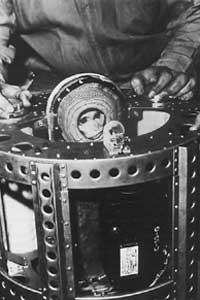Machines guided by thought
2000/11/21 Carton Virto, Eider - Elhuyar Zientzia
Scientific research is constantly advancing and a few years ago science fiction has become a reality. As the brain is the most powerful organ humans have, the desire to know how it works is enormous. Surely you will never get so much, but what we are learning along the way is unpayable. The realm of thought-guided devices, for example, is developing at high speed.
Muscle replacements

The latest issue in the journal Nature indicates that at Duke University in the United States, using signals from a monkey's brain, they have managed to move the arms of a robot. The experiment has been a success, as it has simultaneously repeated the same movements that the robot arm made of the monkey. The monkey is formed to take objects and move the arms from left to right, so the movements that have managed to imitate at the moment are these.
Research can have interesting applications in medicine, especially for those who have lost their limbs, to prepare prostheses and help those affected regain their body control. This invention will prevent the use of muscles as intermediaries to convert brain orders into actions, moving directly from the brain to prostheses.
In the beginning, people completely paralyzed by degenerative diseases of the nervous system will benefit from the new system. When the paralysis is total, the inability to move must add the impossibility of communicating with others, and that is often the worst. For those who are able to control the eyes there are computers that allow to follow and write the movement of the eye: the patient observes the letters written on a screen individually and identifies and writes the letter to which the device looks. But the most severe handicapped cannot control eye movement either.
On the other hand, the ability of the human brain to adapt to new functions can greatly stimulate the field of artificial prostheses. This competition has long been known to researchers. In a blinded person, for example, the parts of the brain in charge of vision receive the contact sensations produced by reading Braille.
Something similar will happen with the prosthesis; the movements that initially can be abrupt are tuning over time, since the brain will internalize the procedure of propulsion of the prosthesis.
Project description
To read the thoughts, the monkey has been applied small cone-shaped electrodes in the five parts of the brain. These electrodes are special because they cause the growth of nerve cells in the brain. In this way a permanent connection between the electrodes and cells is achieved and researchers can obtain all the brain information of the monkey in real time.
This information is processed by a special computer. In fact, the electrodes store all kinds of signals and from this mixture we only have to distinguish those corresponding to the movement. The signals of interest, once filtered, are amplified and combined by the computer. The computer receives and works the information every second and thus prepares the movement that the robot will make. The signal received in each second predicts the movement of the mechanical arm in the next second.
Johan Wessberg's research team has made it possible to overcome several limits. On the one hand, it has managed to solve the problems that existed to move the robot arm in one direction or in three dimensions, and on the other, the signals that have been sent when collecting the objects on the right side have served to move the robot arm to the left. These "general" characteristics will be very useful when performing complex movements in the mechanical arms. The future of robots capable of imitating natural movements is getting closer.

Gai honi buruzko eduki gehiago
Elhuyarrek garatutako teknologia





